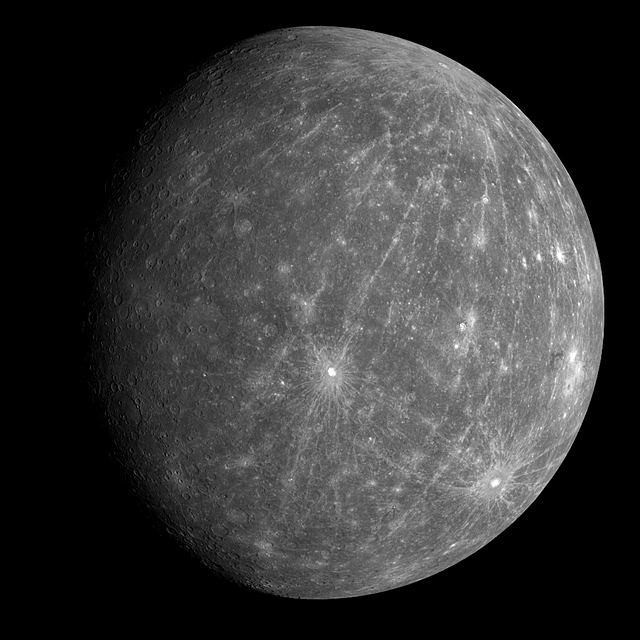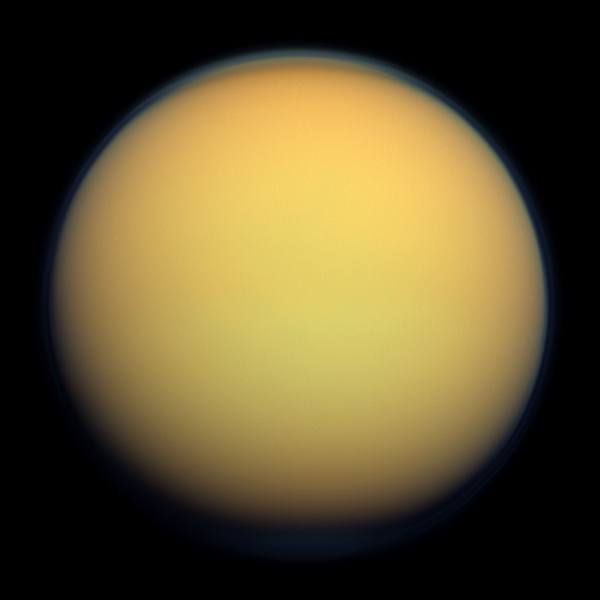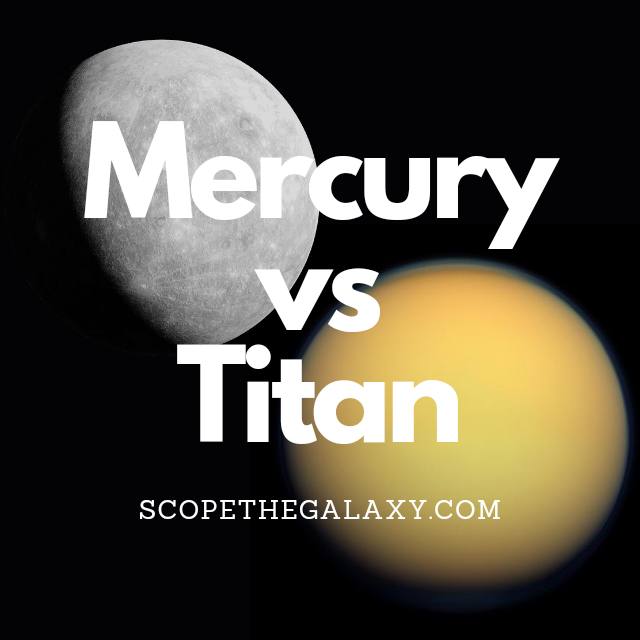*This post may contain affiliate links. This means we may make a commission if you purchase an item using one of our links*
The main differences between Mercury and Titan are that Mercury is the closest planet to the Sun, has a very thin atmosphere, has no objects orbiting it and is 4,879km in diameter whilst Titan is a natural satellie that orbits Saturn, is the bigger of the two with a diameter of 5,150km and has a far thicker atmosphere and a water cycle, along with rivers and lakes similar to that Earth.
There are other differences between the two so continue reading for a more thorough breakdown of what these two celestial bodies are, their similarities and the difference between the two.
What Is The Planet Mercury?
Table of Contents

Mercury is the planet closest to our Sun and would fall under the terrestrial planet moniker. Out of the 8 main line planets Mercury is also the smallest, coming in at 4,879km.
This planet is known for having its fair share of craters, which is mostly down to its thinner non protective atmosphere that is unable to stop interstellar debris from striking its surface.
Despite its close proximity to the Sun, Mercury is not the hottest planet in our solar system but, it does come in second, just behind Venus. It’s surface temperature is around 430 degrees on the upper end with the average temperature around 167 degrees Celsius whereas its core is far hotter at around 1,600 – 3,000 degrees Celsius.
Due to it close proximity to our local star, Mercury is unable to sustain a moon around its orbit and even has a very unique rotation around the Sun where it has 3:2 orbital resonance with the Sun.
As for how long it takes for the planet to rotate around our yellow dwarf star, its the shortest time period of 88 days for obvious reasons, whilst a single day on the planet takes 58.65 Earth days to complete. Its axial tilt is only 2 degrees to the right, making it amongst the straightest planets in the solar system too.
What Is The Moon Titan?

Titan is Saturn’s largest moon and the second biggest moon in the entire solar system, with a diameter of 5,150km. This would make it even larger than the planet Mercury which is only 4,879km, and significantly larger than Pluto also.
As a result, Titan’s gravitaional strength stands at around 1.352 m/s²
It is the only natural satellite in our solar system that is composed similarly to Earth, where it has a thick atmosphere made primarily of nitrogen (95%) along with smaller amounts of methane (5%). It has rivers and lakes on its surface along with a water cycle very similar to that of Earth, where essentially water evaporates and eventually lands on the satellites surface.
Therefore, much like Earth, Titan has a terrestrial based body but, there is a difference in their atmospheric pressure. The pressure on Titan’s surface is around 60% greater than that of Earth’s surface but, it isnt nearly as dense.
Nevertheless, it is still far denser than most other bodies at 1.88 g/cm³. As a result, Titan’s mass is 1.345×10^23 kg.
In regards to its temperature, Titan is on the colder side where it averages around -179 degrees Celsius whilst its core’s temperature is actualluy very cold in comparison to other entities falling between 226 – 526 degrees Celsius.
As Saturn is the 6th farthest planet from the Sun, it will take Titan roughly the same amount of time to orbit the Sun, which would fall around 29.4 years.
It takes Titan 15 days and 22 hours to orbit Saturn. A day is 15 days and 22 hours also as it is tidally locked to the gas giant.
Similarities Between Mercury And Titan
Titan and Mercury do have their fair share of similarities, which in this case would include the following:
- Both have a hotter central core.
- Both are a spherical in shape.
- Both are terrestrial planets.
- Both have an atmosphere and a rocky surface.
- Both have no other natural satellites orbiting them.
Differences Between Mercury And Titan
In regards to the differences between the two, they include the following:
- Mercury is actually the smaller of the two with a diameter of 4,879km whilst Titan’s diameter is 5,150km.
- Titan has an atmosphere that is 4 times Earth’s thickness and is composed of 95% nitrogen and 5% methane whilst Mercury’s atmosphere is so thin that it’s essentially negligible.
- Titan is the cooler of the two celestial bodies as it averages -179 degrees Celsius whilst Mercury averages around 167 degrees Celsius.
- Mercury is an official planet whereas Titan is a natural satellite/moon that orbits another entity.
- Mercury is in a 3:2 orbital resonance when orbiting the Sun whilst Titan is tidally locked to Saturn.
- Titan orbits Saturn in an elliptical pattern whilst Titan does so in a circular pattern.
- A day on Titan takes 15 days and 22 hours whilst a Mercury day is 58.65 days.
- Mercury will orbit the Sun in 88 days whilst Titan will take roughly the same time as Saturn at 29.4 years.
- Titan’s axial tilt is 27 degrees whilst Mercury’s is 2 degrees.
- In regards to density Mercury’s is 5.43 g/cm³ whilst Titan’s density is 1.88 g/cm³.
- As for mass Mercury’s is 3.285 × 10^23 kg whilst Titan’s is 1.345×10^23 kg..
- Mercury is composed mostly of rocks whilst Titan is composed of water ice and rocks.
- Titan has a water cycle whereas Mercury does not.
- In regards to gravitational strength, Mercury’s is 3.7 m/s² whilst Titan’s is 1.352 m/s².
- Mercury’s core temperature is 1,600 – 3,000 degrees Celsius whilst Titan’s core is between 226 – 526 degrees Celsius.
Summary
Both of have their fair share of differences as can be seen above.Whether it be their differences in size, mass, density, their atmosphere or simply the manner at which they function. It’d be hard to compare the two, even if both Titan and Mercury are terrestrial entities.
In fact based on the fact Titan has an atmosphere, if not for the fact it orbits Saturn it could easily fall under the planet bracket but, it isn’t a planet and as result quite different from Mercury.

